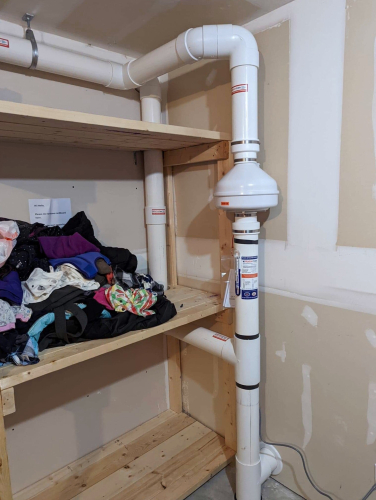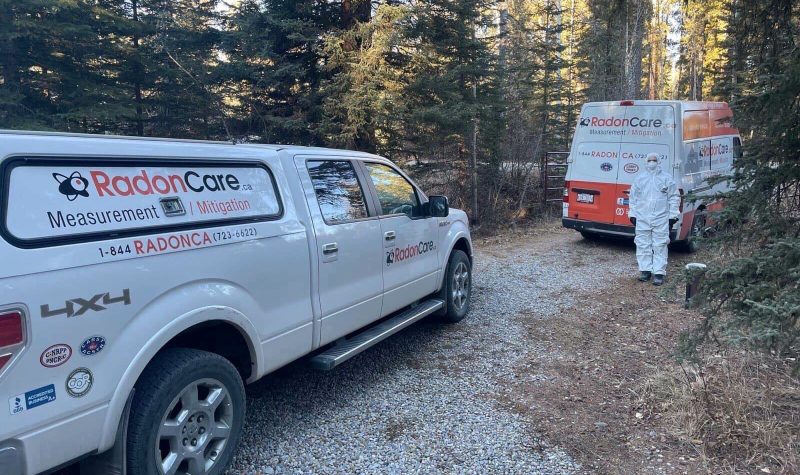Revelstoke took part in the national study last winter from Take Action on Radon's 100 test kit challenge. The results showed that the city is in a radon hot zone, but researchers and experts say, it's a problem with a solution because the radioactive gas can easily be blown out of buildings.
Exposure to radon causes lung cancer. The gas is emitted when the elements Radium, Thorium and Uranium break down in the dirt. It seeps into buildings through the flood and is the second leading cause of lung cancer after smoking.
Andrew Arshinoff is a radon mitigation expert in Calgary. He owns RadonCare, and he has recently started making the trip to Revelstoke to install mitigation systems.
In mid-August, he was in town to install systems in seven households.
"You don’t just want to drill a hole in the ground and put a fan in," Arshinoff said.
The formation of the gas creates a higher pressure under houses than inside them, which pushes the gas into buildings.
"So what we want to do then to mitigate it, is reverse that. We want to create a lower pressure underneath the house than we have in the home," Arshinoff said.
That creates a path of least of resistance, helped by fans, for the gas to flow towards the mitigation pipe, and up and out of the building, instead of into the basement and upper levels of buildings.
Every building is different and Arshinoff's team uses what's called a micromanometre to measure the pressure in different part of the basement to make sure they have it right. Sometimes they have to install a few mitigation pipes, and drill a few holes.
Arshinoff used to install HVAC systems. When he had his first child, his brother, a cancer researcher, called him up and told him to check his radon. He looked into it, and ended up installing his own system. His friends started asking him for help, and now, it's all he does.
It can cost up to $4,000 to have a system installed, depending on how complicated the building is. Arshinoff says to think of it as being a little bit cheaper than installing air conditioning.
There currently aren't many subsidizes available to help offset the cost of installation. Arshinoff says he helps people out who live in a home with high levels of radon, but can't afford to mitigate. He says to reach out if you need help.

Radon mitigation means installing a pipe with a fan to blow radon up and out of basements. Photo by Andrew Arshinoff.
Radon gas is measured in Becquerels per square metre. Health Canada says anything higher than 200 Bq/m² is dangerous.
In order to test for radon levels, it's important to leave a monitor in for at least three months, because the levels of gas fluctuate depending on the season.
Arshinoff's company sells radon test kits. They're also available at hardware stores and online at Evict Radon.
Radon was only discovered as a problem in residential homes in the mid-1980s. Before that it was only known as a problem in the context of mines. This is according to Dr. Aaron Goodarzi, a researcher at the University of Calgary.
Canada has the second highest rates of radon in the world, after Poland. One in five homes are higher than Health Canada's recommended level. In the interior of B.C. it's higher, one in four homes are above the recommended level.
The current theory as to why is a combination of how newer homes are built air-tight, and the way we heat our homes in Canada.
In Sweden, radon levels used to be higher in homes than Canada. Now, radon levels in Swedish buildings are nearly non-existent, and they don't have radon mitigation systems.
"You better believe the Swedes have built among the most energy efficient houses, on this planet," Goodarzi said.
Researchers don't know why there's such a discrepancy between radon levels in Canada and Sweden, but they suspect it's because the majority of Swedish properties use distribution pipes to send radiant heat into buildings through the floors.
In Canada, we generally use forced-air heating, where fresh air is pumped into a furnace and blown into a building after it's warm.
"That's our best working theory as of this time," Goodarzi says.
The threat of exposure to radon bears out in statistics. In Canada and Sweden, about 11 to 12 per cent of the population smokes. Rates of radon are much higher in Canada than Sweden, 467 per cent higher.
"Lung cancer rates here are enormously higher than they are in Sweden," Goodarzi said, "and I'm talking about cases and mortality."
A report from the Canadian Cancer Society showed Canada has amongst the highest rates of lung cancer incidences and mortalities in the world.
"And you better believe we don't have the highest smoking or air pollution rates," Goodarzi said.
B.C. has low rates of lung cancer, but it has among the highest rates of what's called never-smoker lung cancer. Typically one in five lung cancer patients have never smoked. In B.C., it's about one in three.
Population health studies published in 2005 in North America, Europe and China show that the relative risk of lung cancer goes up by about 16 per cent for every 100 Bq of radon that someone lives with over the long term.
"So for example we see houses all the time across B.C. in the interior and the prairies at 1000 Bq," Goodarzi said.
"[People who live in them] are going to be adding 160 per cent to their lifetime risk of lung cancer."
Despite this, Goodarzi said there's a positive side to radon. It's a fixable issue. Test your home for radon, and install a mitigation system if it's high. Re-test every five years or after a renovation.
In the link below, you will find two interviews: The first with radon mitigation specialist Andrew Arshinoff and at 11:35, the second with Doctors Aaron Goodarzi and Dustin Pearson from the University of Calgary.


